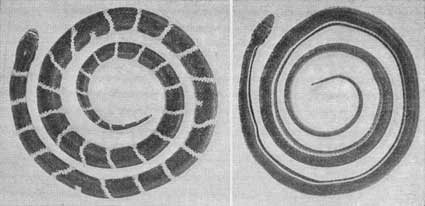|
Animal Life in the Yosemite
|

|
|
THE REPTILES BOYLE KING SNAKE. Lampropeltis getulus boylii (Baird and Girard) Field characters.—Size medium; total length up to 42 inches, body diameter 1 inch or less; scales on back smooth, in 23 (or 25) rows. Coloration in alternate broad bands of brownish black and creamy white, which, brokenly, encircle the body. (See fig. 63a.) Occurrence.—Moderately common in Upper Sonoran Zone on west slope of Sierra Nevada. Recorded at Pleasant Valley and at Smith Creek (6 miles east of Coulterville). Inhabits shaded ground with mixed vegetational cover. The Boyle King Snake or "milk snake" is a strikingly colored animal with broad alternate bands of black and white crossing the back from the head to the end of the tail; these markings extend down the sides and onto the under surface, but do not meet evenly on the belly. This species is a terrestrial snake and is usually to be found in the vicinity of thickets or other close vegetational cover. It does not affect the pure chaparral on the drier slopes, nor does it ordinarily occur in open grasslands. In general demeanor the Boyle King Snake is a quiet reptile, its ordinary movements being slow and deliberate. However, it bears the same reputation as the Coral King Snake, namely, that of using other snakes for food when chance offers.
|
| <<< PREVIOUS | CONTENTS | NEXT >>> |
Animal Life in the Yosemite ©1924, University of California Press Museum of Vertebrate Zoology grinnell/reptiles11.htm — 19-Jan-2006 | ||
